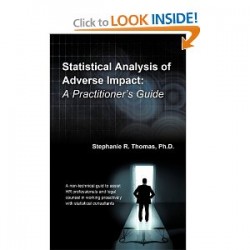 Statistical Analysis of Adverse Impact: A Practitioner’s Guide by Stephanie R. Thomas
Statistical Analysis of Adverse Impact: A Practitioner’s Guide by Stephanie R. Thomas
I know, adverse impact analysis is not my usual fare.
However, I’m working on a new project, and I need to expand my horizons a bit. To be honest, I didn’t know what to expect from this book. I thought I might pick up an idea or two, but I wasn’t prepared to be sucked into the world of statistics and how they can be used to prove (or disprove) a claim of adverse impact.
Being in the government contracting industry, I have the OFCCP and the EEOC to think about, which means the topics in the book were exactly what I need to know to do my job better.
Highlights from Statistical Analysis of Adverse Impact
- The author sets the tone early by describing the unique situation surrounding adverse impact. It often develops as an unintended result of a policy or rule. The original Griggs v Duke Power case was the perfect example of that. It’s hard to train managers to avoid something like adverse impact when it might not even be their choices leading to the discrimination. Great point. This goes beyond simply telling managers that “diversity is important” and requires that tests and selection methods are not “adversely impacting” any protected classes.
- Flash back to college (or your PHR/SPHR course). The difference between disparate impact and disparate treatment, on a basic level, is intent. When we think of traditional discrimination cases where a motive is clear and intentional, disparate treatment is the category those fall under. Disparate impact is more subtle/unintentional much of the time, though the discrimination can still be damaging to one or more protected employee groups.
- The four stages of a disparate impact claim are covered early in the book, and she offers a 30,000 foot view of an example court case involving this form of discrimination. Great executive summary on what to expect in each of the four main steps of an adverse impact analysis claim. In addition, the 4/5ths rule is also covered in great detail, giving you a firm grasp on the legal threshold for determining if a claim is valid.
- Causality is difficult to determine via statistical adverse impact analysis, and I’m glad the author took the time to explain that factor. Even if you go through the process and determine that you are impacting a group, the statistical portion of the analysis doesn’t necessarily help you determine the root cause. At that point it’s time to put on your detective hat and start looking at what might cause the results you are seeing.
- When we usually think of a discrimination claim of disparate impact, we immediately look at hiring practices. However, it covers other areas that are even more important, because the results aren’t always as obvious (not hiring 40% of a protected class stands out, not promoting or using them well probably doesn’t). The other key areas that need to be considered besides hiring (applicant flow) include utilization analysis, promotion analysis, and RIF (reduction in force) adverse impact analysis. You could easily be a target if you are not treating all classes of employees the same in those key areas.
- Stephanie takes the time (thank goodness) to look at social media and its impact. The bottom line: recruiting via social media exclusively might cause adverse impact, but that doesn’t mean you should ignore it completely. As I’ve said in the past, it needs to be one of many tools you use to find and hire great candidates.
Conclusion
For the average HR person without policy-making responsibility, this book is very in depth and doesn’t really have a lot of impact on your day to day. However, there are a few groups of people I would definitely recommend this book to: anyone facing (or who has faced in the past) a disparate impact claim, anyone who suspects their hiring/promotion/etc. practices might be suspect (I’m in this group!), or those looking to hire a statistical consultant to help ensure they are compliant. (By the way, if you are looking for a statistical consultant, connect with Stephanie here.)
If you are in any of those groups, this is going to be a great primer to help you understand the process for dealing with disparate impact claims and how claims are proved/disproved with statistical adverse impact analysis.
Click here to get your copy of the book.
Click here for other book reviews, review policy, and disclosure.